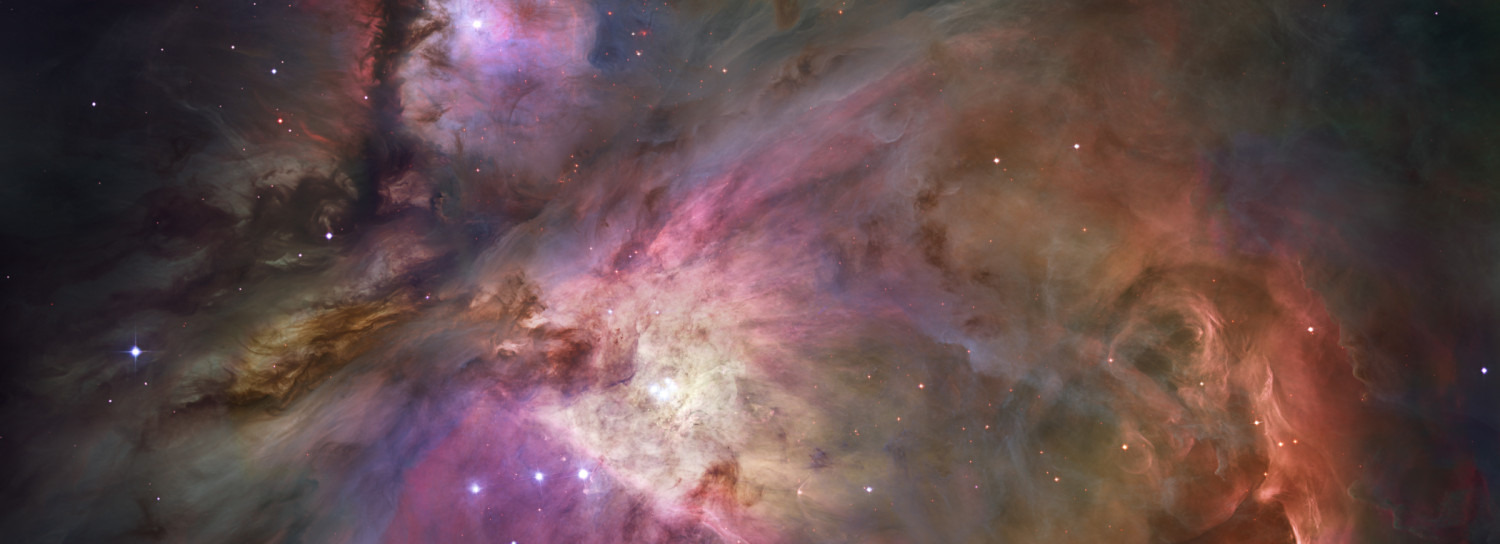This is the first entry in a series of posts that will discuss some of our vacations over the last few years. How those travels have personally shaped my views of our world, and more recently, my views on climate change. The first two entries will cover our 2019 journey to Glacier National Park, then north to Banff, Yoho, and Jasper National Parks in Canada.
**********
On the 9th of August of this year, we packed up the Forester, piled in, and drove west again. Most of our driving family vacations have been west, including the Black Hills, Glacier, Yellowstone, and the National Parks of Colorado. For some odd reason, when we have journeyed east, we have flown. West again it was this year, however, and so at lunch time on a Friday, Brenda and I left work, swung home, picked up the kids, and headed out on I-94. This trip would be a different in one key, sentiment inducing way. Our oldest of two daughters had graduated from high school in the spring. And while she had already turned eighteen, and was bound for UND in the fall, it would be the last family road trip where we could sort of think of her as a child.
Our agenda for ambitious. We would put over 2500 miles on our Subaru in nine days and eight nights of driving through two states and three Canadian provinces. We had the Rocky Mountains, wildlife, rivers, waterfalls, lakes, and ice on our minds.
My wife and I have tried, as best we could, to take our girls to new places every year. To see new things, experience news environments, learn something about the greater world we live in. Okay, the greater continent we live on. We don’t exactly travel the word, much. Our shortened 2016 vacation was a cruise to Nassau, the Bahamas, which is the farthest abroad we have journeyed with our kids. European vacations or island jaunts are not usually in our area of realistic expectations, at least not while saving for two college educations for our offspring. But North America, the Northern Plains and Midwest? We have always been determined to not become someone who “goes to the lake”, or to the same resort, year after year after year. We have done a fair job, I hope. Treasured memories, all of these trips, for both of us. And for me, personally, life itself fulfilled.
We headed towards the sunset on the interstate. One of the trip proposals Brenda and I had tossed about when the girls were young was a cheesy idea of driving around to all the giant monuments of Americana in our local region. The big fish, turtles, balls of twine, bison, lumberjacks and blue ox’s of the world. We made it to a few over the years, but never did that road trip. A few miles of east of Bismarck, North Dakota, stands Salem Sue, a 38 foot tall, 50 foot long, fiberglass Holstein.

(https://www.roadsideamerica.com/story/2716) Looking over the town of New Salem, Sue was constructed in 1974 for $40,000. It’s a fitting monument for a small section of North Dakota that is home to the state’s largest dairy industry. Seeing her gazing out over the interstate, it was a spur of the moment decision to pull off and drive up the hill to the lot at Sue’s feet and take a look around. And driving back down that hill and glancing in the rear view mirror, for just a moment, my kids didn’t look like the young 18 and 15 year old women they had become.
They looked like they were 11 and 8 again.
A few hours later we pulled into Glendive, Montana, where we would spend the first night of our journey west towards the mountains. Arriving before dusk, we sought out Makoshika State Park. I had read online that this park rivaled anything that either North or South Dakota had in terms of badlands geology. Those reviews were accurate. Makoshika (http://stateparks.mt.gov/makoshika/), located on the edge of Glendive, is a stunning canyon.
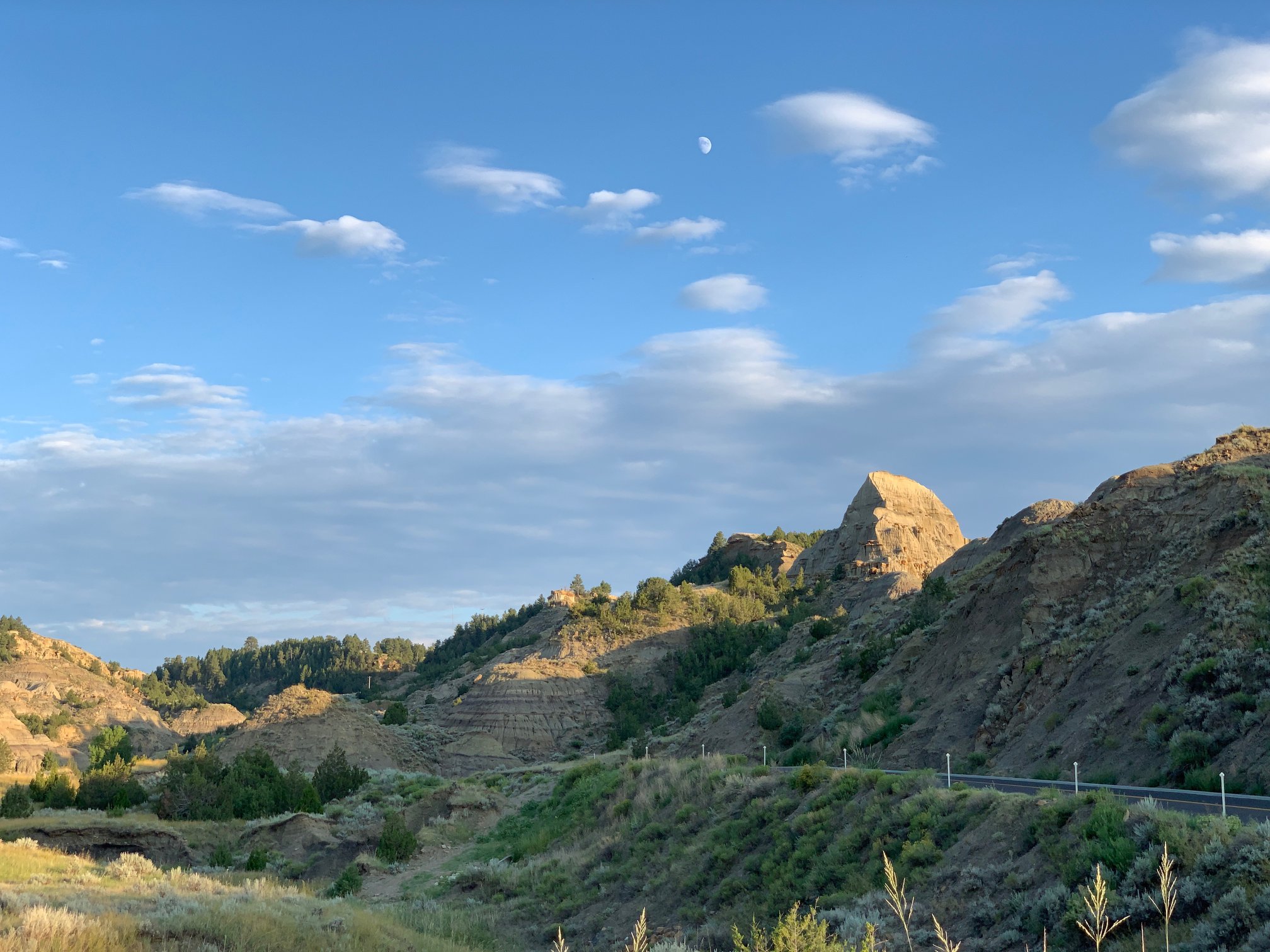
Carved out of the Hell Creek Formation, which is an exposure of clays, mud, and sandstones from the Cretaceous – Paleogene boundary, the Badlands formations of Makoshika are some of the most stunning I have seen. The park contains active fossil dig sites, and has produced Triceratops skeletons as well as other finds. The sand, tan, orange, and red hues of the rock deposits are punctuated by the green of sagebrush, cottonwood, and junipers. We drove into the park after the visitor center had closed for the evening, so we folded up our entrance fees into the deposit envelop and left it in the cash box before driving the length of the main park road. After passing a campground and a pavilion hosting what looked like an educational event, we drove up to the top of one of the formations, seeing our first wildlife of the trip, a scruffy looking deer walking in the brush along the road. At the top if was a short hike to a magnificent overlook, looking back down the canyons. The K-T Boundary,
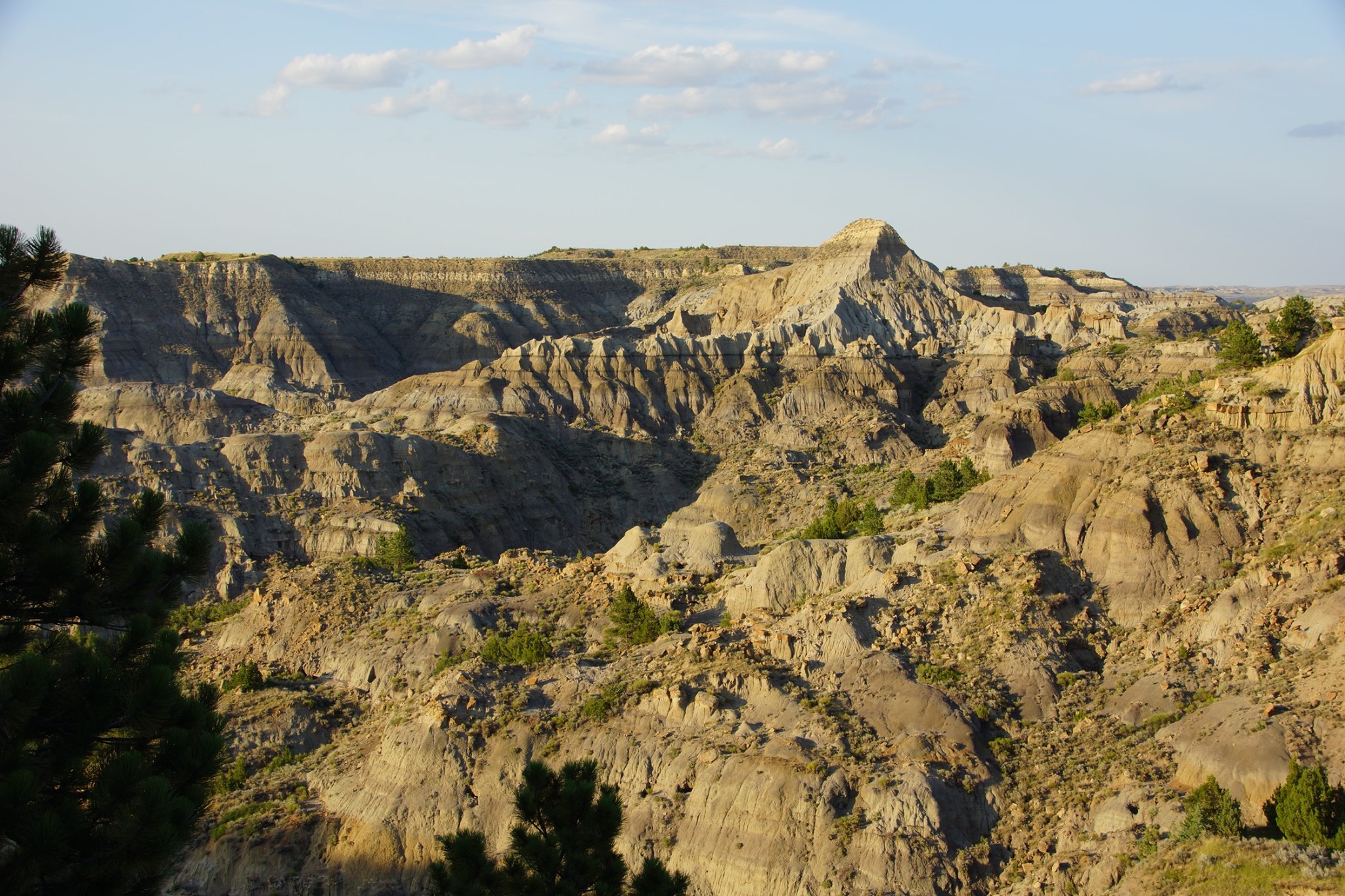
the line of sediments, carbonized material, and iridium that marks the impact of the asteroid approximately 65 million years ago that ended the reign of the dinosaurs, is clearly visible in Makoshika. More so than in perhaps any other area I have visited, and it showed up nicely in the photos we took from the overlook.
Makoshika was a place I think all of us could have spent a full day in. The next morning, however, would bring the longest day behind the wheel of the entire trip with nearly 580 miles planned. Side note – over the years it has become obvious that our youngest absolutely detests sleeping in the same hotel room with us. Our breathing, snoring, white noise apps, and rustling, annoys her with such intensity that it often bubbles over into annoyances to the rest of us. Her tossing, turning, punctuated by “shut ups” or exaggerated sighs, frequently keeps the rest of us from having a good night’s sleep either. This in turn creates not just one cranky person the next morning, but four. So rather than opt for basic, two-bed hotel rooms this trip, on every night I booked larger or multi-room suites. With two beds and a couch, we managed to put some separation between the four of us and mostly manage peaceful slumber.
We woke early, took in the breakfast bar included with the hotel room (another must I usually try to book now), and headed out. It was a hard push to our first major site of the trip, Glacier National Park. With the weather that weekend questionable – the mountain areas had been stuck in a rainy pattern for over a week – I opted to drive the Going-to-The-Sun Road from Saint Mary all the way to the west side of the park, and then turn around and drive it again the next day. We had identified one major site in the park, Hidden Lake, that we had not seen during our first visit in 2012, that was a must-do. And if the weather was rough on Saturday afternoon when we got there, maybe it would clear by Sunday on the way back. The strategy paid off. When we arrived at the east side of Glacier mid-Saturday afternoon, the skies were overcast, the air heavy with moisture. We headed west, stopping for photos at the Wild Goose Island lookout
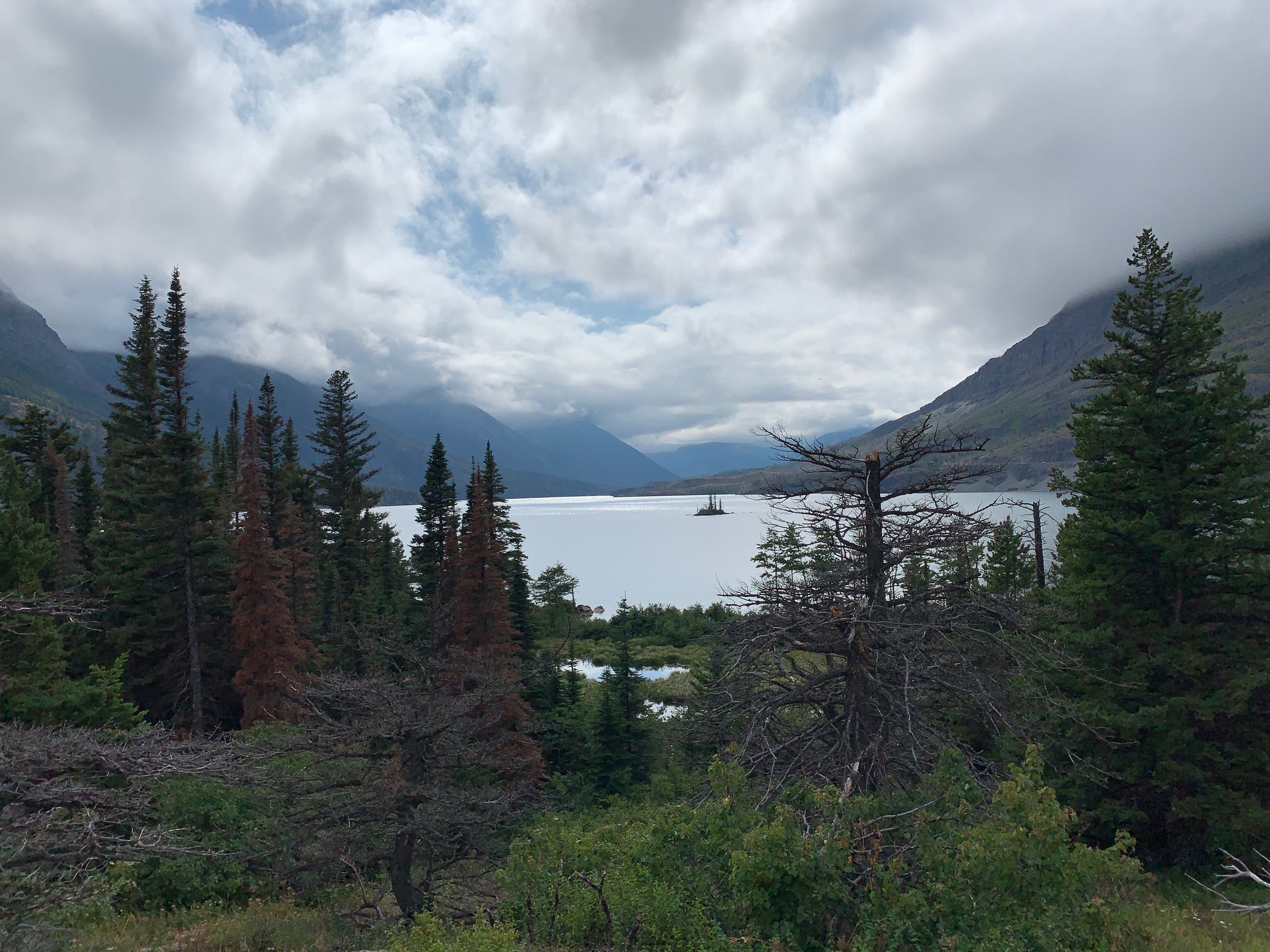
and several other spots, while marking locations to try the next morning. We also stopped at Logan Pass, the beginning of the Hidden Lake Overlook trail, but it was indeed socked in with clouds. As in actually in the clouds. We would not hike that afternoon.
We did not rush through the park that afternoon, despite the weather. Brenda and I are partial to sun, or at least partial sun, for photographs. Our girls, however, fully embraced the clouds and moisture that enveloped us that afternoon and evening. And, in
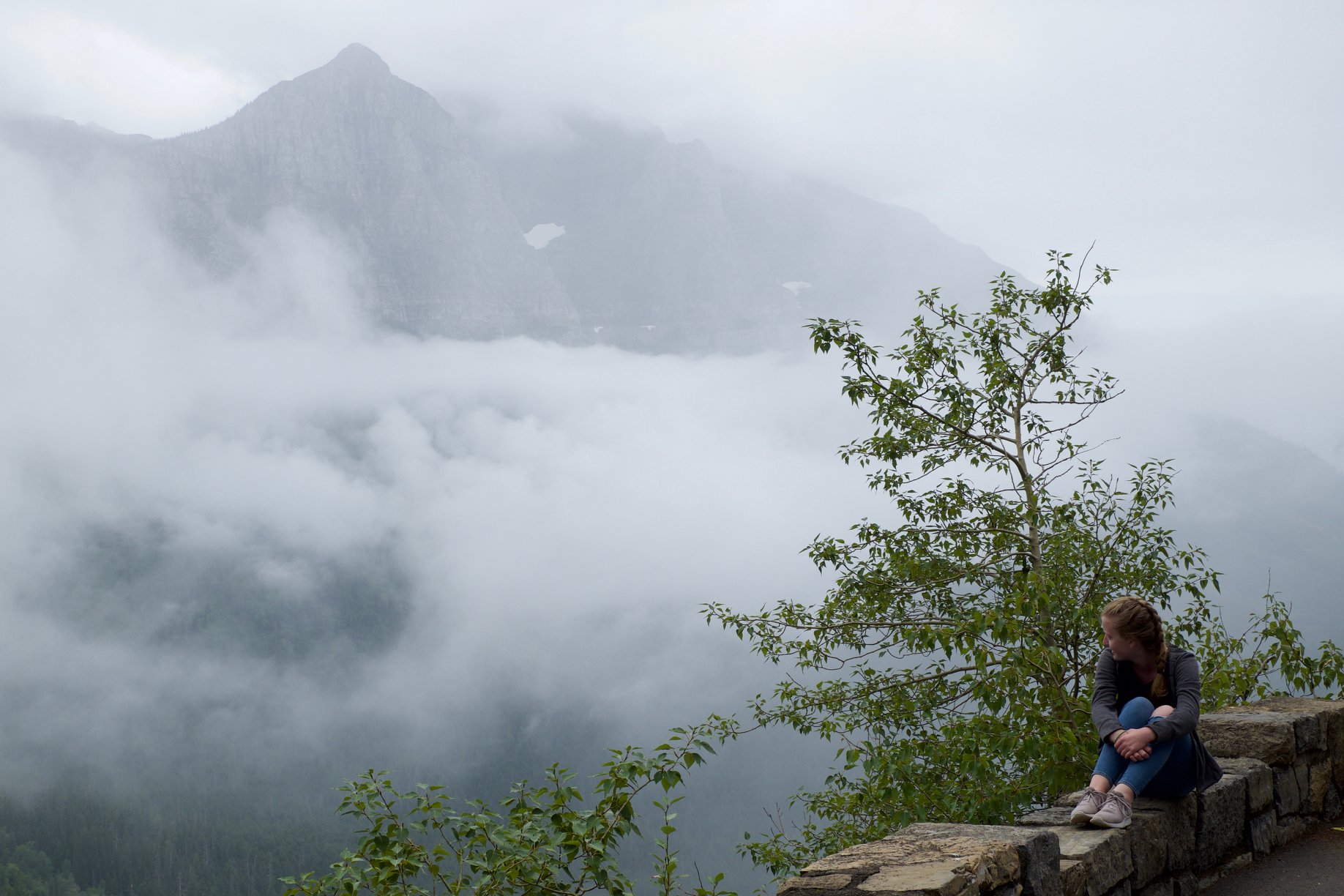
retrospect, they were not wrong. The setting, high in the mountains, with forests, falling water, drops offs, and residual snow and ice, can be positively Middle Earth-like when you are cloaked in a blanket of fog, your visibility slightly hindered by the mists. The lighting, not the brilliant crisp reflections of high-altitude sun, can reveal subtle textures your eyes (and the camera) might otherwise miss. And the ability to separate oneself from the rest of nature, even while not wandering far off the roads, begins to fade just a little. The local biosphere beings to wrap you in its blanket on days like that, reminding you that as a human, you are a part of the environment, not separate and above it.
There is perhaps no place better in the United States than Glacier National Park to witness and reflect on humanities long-term impact on our biosphere. My “climate awakening” had occurred while deployed to Afghanistan in 2012, and we have visited Glacier for the first time that same summer after I returned. With younger children, the zeal of being back on U.S. soil, and the main attraction for me on that trip being Yellowstone (I was also in the midst of peak interest in volcanoes), I didn’t pay as much attention to the local climate at Glacier. This year, however, ice was on the forefront of my mind. Or rather the lack of it.
2017 reporting in The Guardian (https://www.theguardian.com/environment/2017/may/11/us-glacier-national-park-is-losing-its-glaciers-with-just-26-of-150-left) points out that the average temperature in Montana is warming at nearly twice the global average. Glaciers, which have been in the Montana Rockies for over 7,000 years, are quickly melting away. The park had 150 identified glaciers in 1900 – today, there are 26. Signage and views from the Jackson Glacier Overlook make it all too evident that the park has changed dramatically over the last century. You can be hard pressed to even spot what remains of Jackson Glacier. The United States Geological Survey (https://www.usgs.gov/centers/norock/science/retreat-glaciers-glacier-national-park?qt-science_center_objects=0#qt-science_center_objects) estimates that the lower 48 will be devoid of permanent glacial ice by around 2050. This has profound consequences for rivers and other sources of fresh drinking water in what can otherwise be a dry, barren environment. Not only will the nearly 3 million yearly visitors to Glacier National Park no longer have a chance to see the ancient ice fields which have helped carve and shape our continent, but downslope prairies and ranchlands will feel the impact of reduced water from mountain sources. Human civilization on a global basis will face even harsher consequences, as many nations are far more dependent on glacier-fed rivers and streams for their fresh water than the U.S.A. currently is. All of this is, of course, our own doing, as we are pumping out ten times the amount of CO2 into the atmosphere via fossil fuel emissions than at the fastest natural recorded rate in the geological record. We have put a heated blanket over the Earth, and are now watching the results in real time.
Glacier National Park, despite the loss of ice, is for now still a wonderful, achingly beautiful place. And this is just the view from the road. Our family, while not afraid of the outdoors, is not a full-day, backcountry hiking family. Short, several mile round trips are more our style, and luckily for us, Glacier has opportunities for all comfort levels of adventure seeking. We stopped at several outlooks along Going-to-The-Sun Road on Saturday, but saved most of the hiking for our full day on Sunday. We did stop along the shores of Lake McDonald, exploring the rocky beach line and feasting our eyes on the rough, wind-tossed waters of what we imagined a Scottish loch resembled. Before we left for our hotel in Kalispell, we stopped by Apgar Village, picking up some souvenirs and ice cream. It would be an early morning again on Sunday.
The skies were again overcast the following morning, but not as low, not as threatening. On our way back into the park we stopped by West Glacier, purchasing some more souvenirs and picking up some travel material for the northern half of our trip into Canada. Reversing our route up Going-to-The-Sun road, 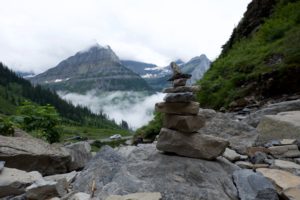 we made stops at McDonald Falls, Red Rock Point, The Loop, Big Bend – with its views of Bird Woman Falls, Mt Oberlin, Clements Mountain, and Mt Cannon – and the Logan Creek pull off, before arriving at the Logan Pass Visitor Center. Still mostly cloudy, but with small patches of blue sky and streaks of sunshine beginning to penetrate the overcast, the Hidden Lake Overlook trail was now in play. In 2012, when our daughters were 11 and 8, respectively, we had been to Logan Pass in early-July. There was snow in the fields, and from the visitors center you could see the long line of people hiking up to the Overlook crossing into and through that snow. We were in shorts, short sleeves, and sandals that day, and with the younger children, we opted to let them explore the Visitor Center area and walk around in the July snow, rather than brave the route up to the overlook. This year, in August, the snow along the trail path was gone, and we were wearing far better shoes. There were bighorn sheep along the trail that morning, one of which appeared eager to use the trail itself for a few minutes. They mostly stayed clear, however. As we climbed higher, the clouds continued to part, and by the time we reached the Overlook itself, it was partly sunny.
we made stops at McDonald Falls, Red Rock Point, The Loop, Big Bend – with its views of Bird Woman Falls, Mt Oberlin, Clements Mountain, and Mt Cannon – and the Logan Creek pull off, before arriving at the Logan Pass Visitor Center. Still mostly cloudy, but with small patches of blue sky and streaks of sunshine beginning to penetrate the overcast, the Hidden Lake Overlook trail was now in play. In 2012, when our daughters were 11 and 8, respectively, we had been to Logan Pass in early-July. There was snow in the fields, and from the visitors center you could see the long line of people hiking up to the Overlook crossing into and through that snow. We were in shorts, short sleeves, and sandals that day, and with the younger children, we opted to let them explore the Visitor Center area and walk around in the July snow, rather than brave the route up to the overlook. This year, in August, the snow along the trail path was gone, and we were wearing far better shoes. There were bighorn sheep along the trail that morning, one of which appeared eager to use the trail itself for a few minutes. They mostly stayed clear, however. As we climbed higher, the clouds continued to part, and by the time we reached the Overlook itself, it was partly sunny.
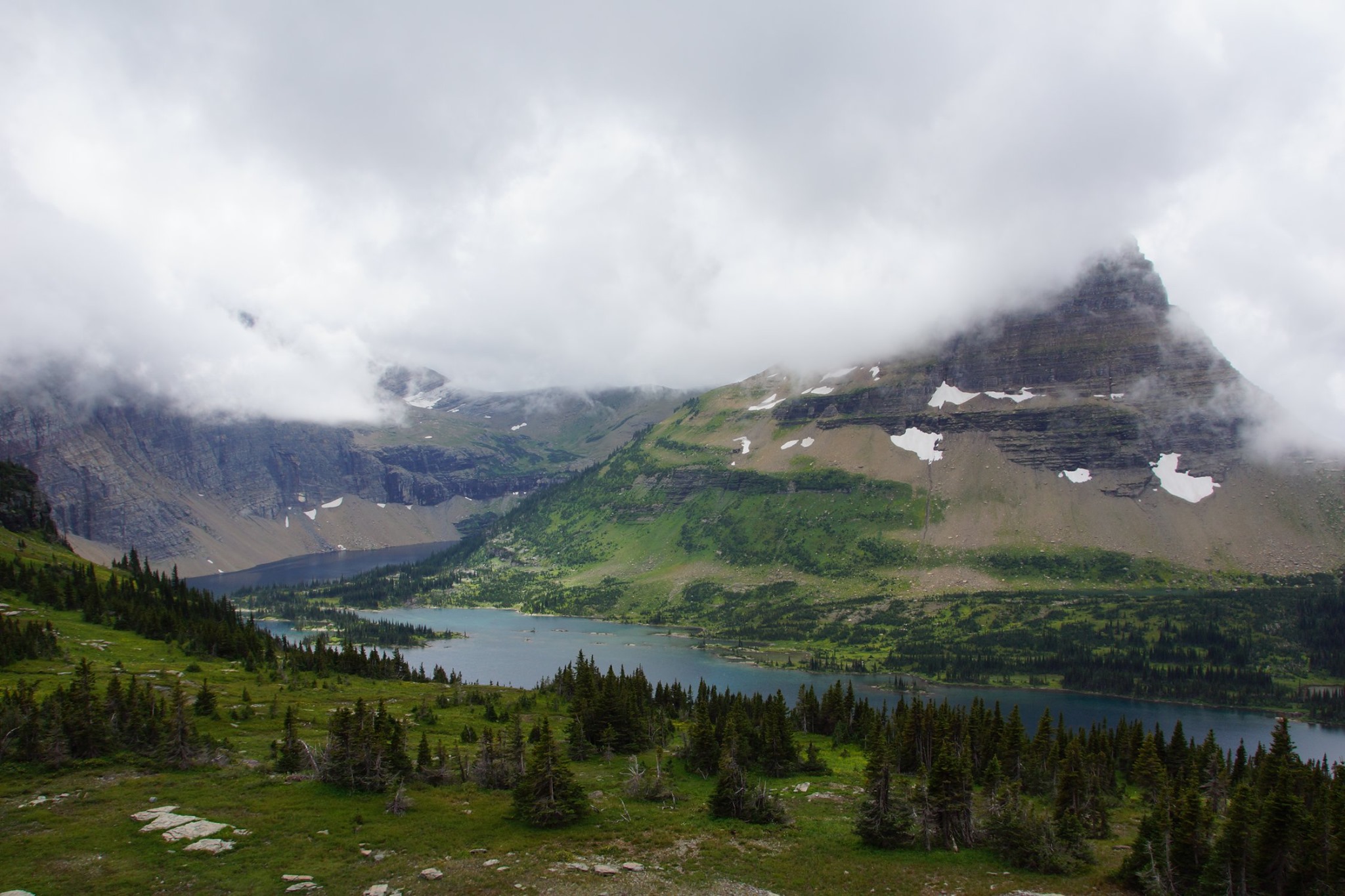
And stunning. Surrounded by the slopes of Clements, Reynolds, and Bearhat Mountains, the blue waters below us reflected the breaking clouds and the shadows from the peaks. The Hidden Lake Trail continues out past the Overlook, becoming one of the true backcountry trails in Glacier. We could see more intrepid hikers on the trail, and down on the shores of the lake itself. A hoary marmot skittered around the rocks nearby. There were of course, a lot of other people with us as well, with multiple languages and dialects being spoken. We lingered there for a while, I am honestly not sure how long, as the skies 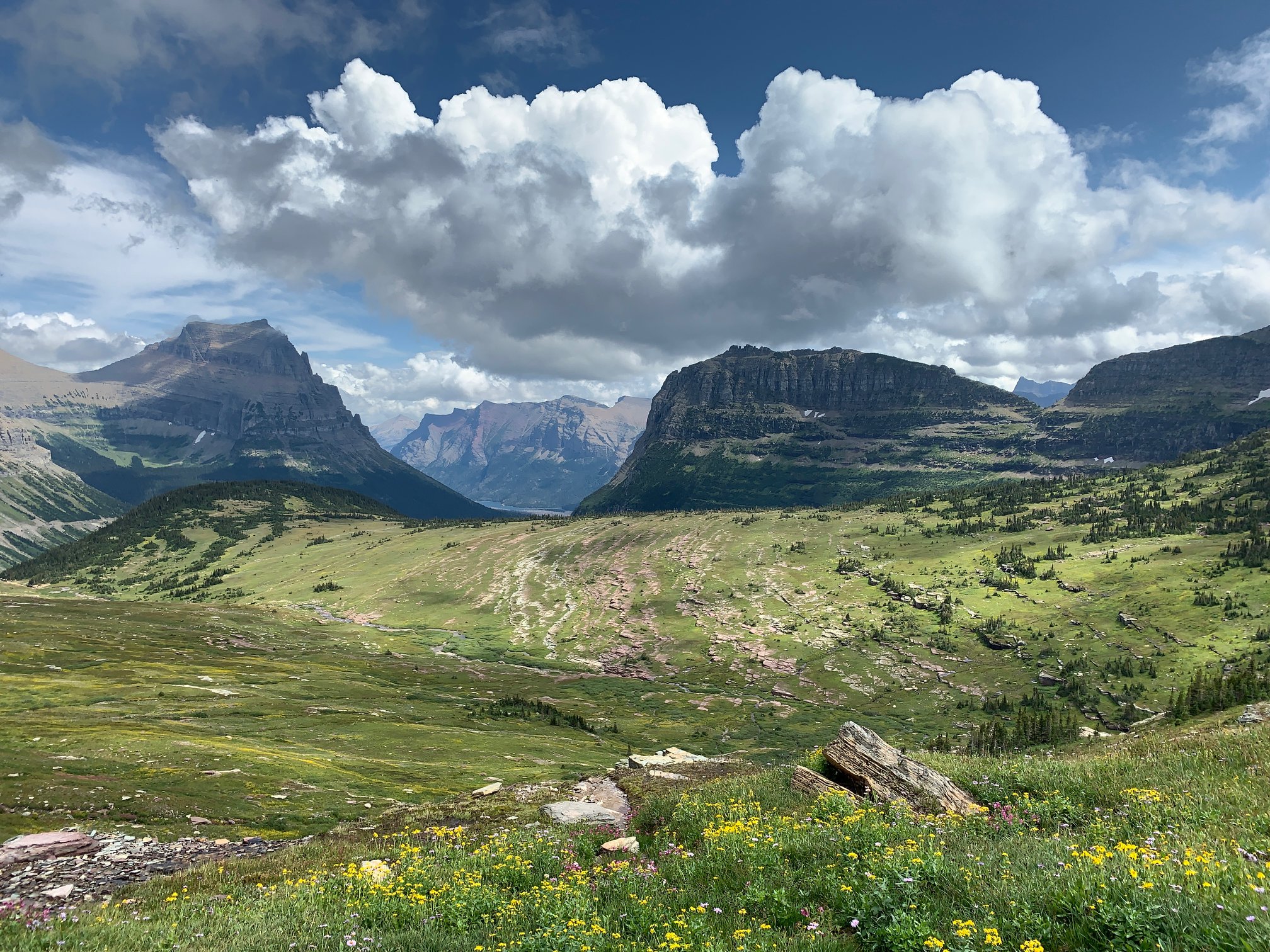 continued to lift. Finally we turned, headed back down to the Visitors Center. We had more sunlight on us, which allowed the colors of the fields, with many flowers in bloom, to jump out. The bighorns
continued to lift. Finally we turned, headed back down to the Visitors Center. We had more sunlight on us, which allowed the colors of the fields, with many flowers in bloom, to jump out. The bighorns
were still there on the slopes to our left, as well as mountain goats to our right. Brenda took some truly good photos of both species, but neither of us was fast enough to capture an image of a fleeting pika darting in and out amongst the rocks. One of the more unique sightings that day was not an an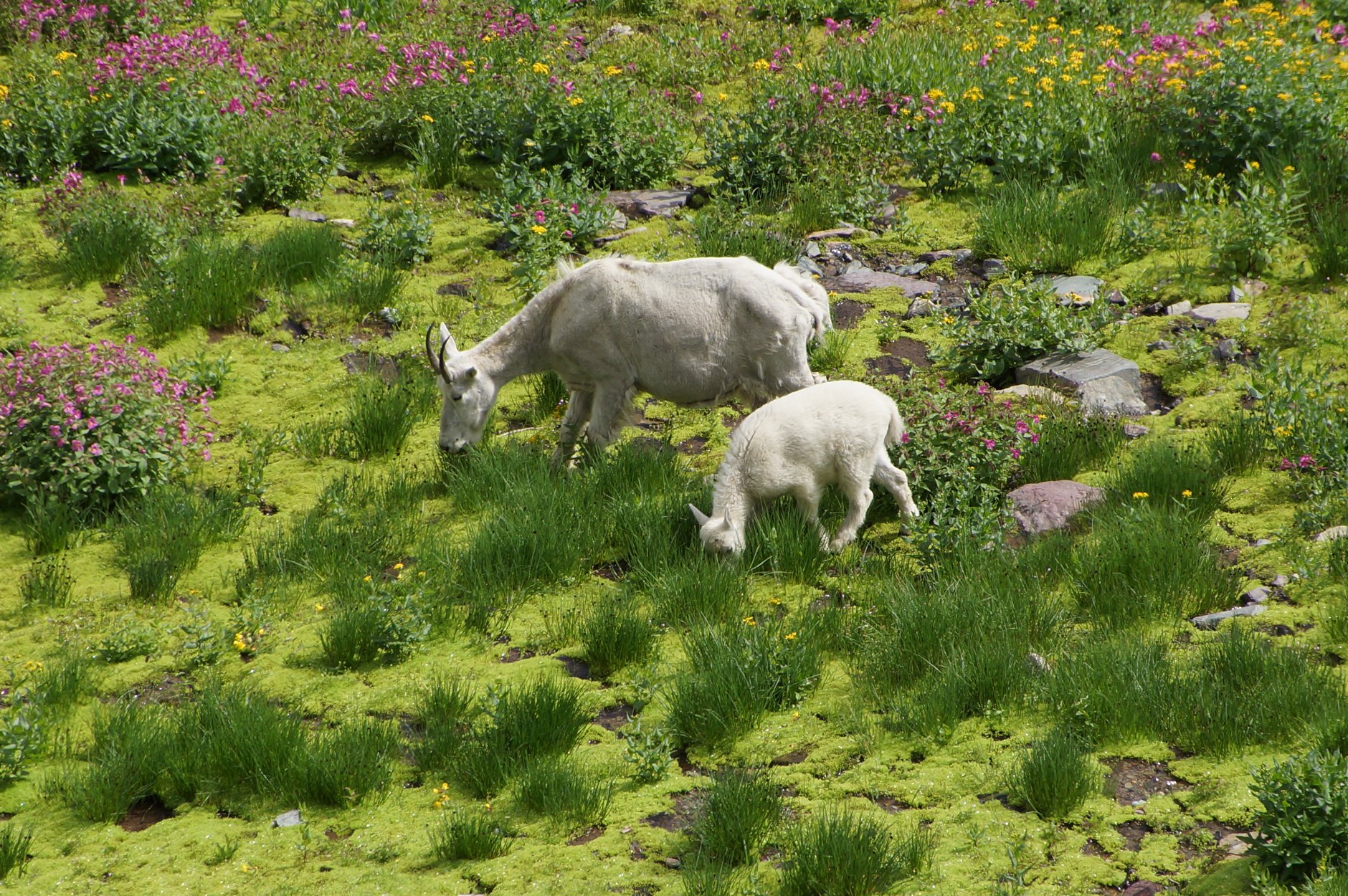 imal species, however, but a young couple out for a run. Yeah. A run. At 7100+ feet above sea level. Maybe a ¼
imal species, however, but a young couple out for a run. Yeah. A run. At 7100+ feet above sea level. Maybe a ¼
of the way back down the trail theypassed us headed up towards the Overlook. About ¾ of the way back down, they passed us again, this time headed down towards the parking lots. Again, they were running. Not walking. Not breathing hard like I was. Not even breathing as hard or audibly as I do on my yearly 1.5 mile fitness test run for the Air Guard at Fargo’s measly 800-something feet above sea level.
Over the entire course of our 2019 road trip, this couple out for a Sunday run stood out as the wildest thing I saw.
After Logan Pass and Hidden Lake Overlook, we continued down the road, pausing at Siyeh Bend, before stopping at our last major point of interest in Glacier for this trip. Parking the car, we took to the Saint Mary Falls trail and hiked a couple of miles to the falls. The trail passes through area of forest that was burned in the 2015 Reynolds Creek Fires, with blackened, scared, trunks still standing amongst some of the new growth. 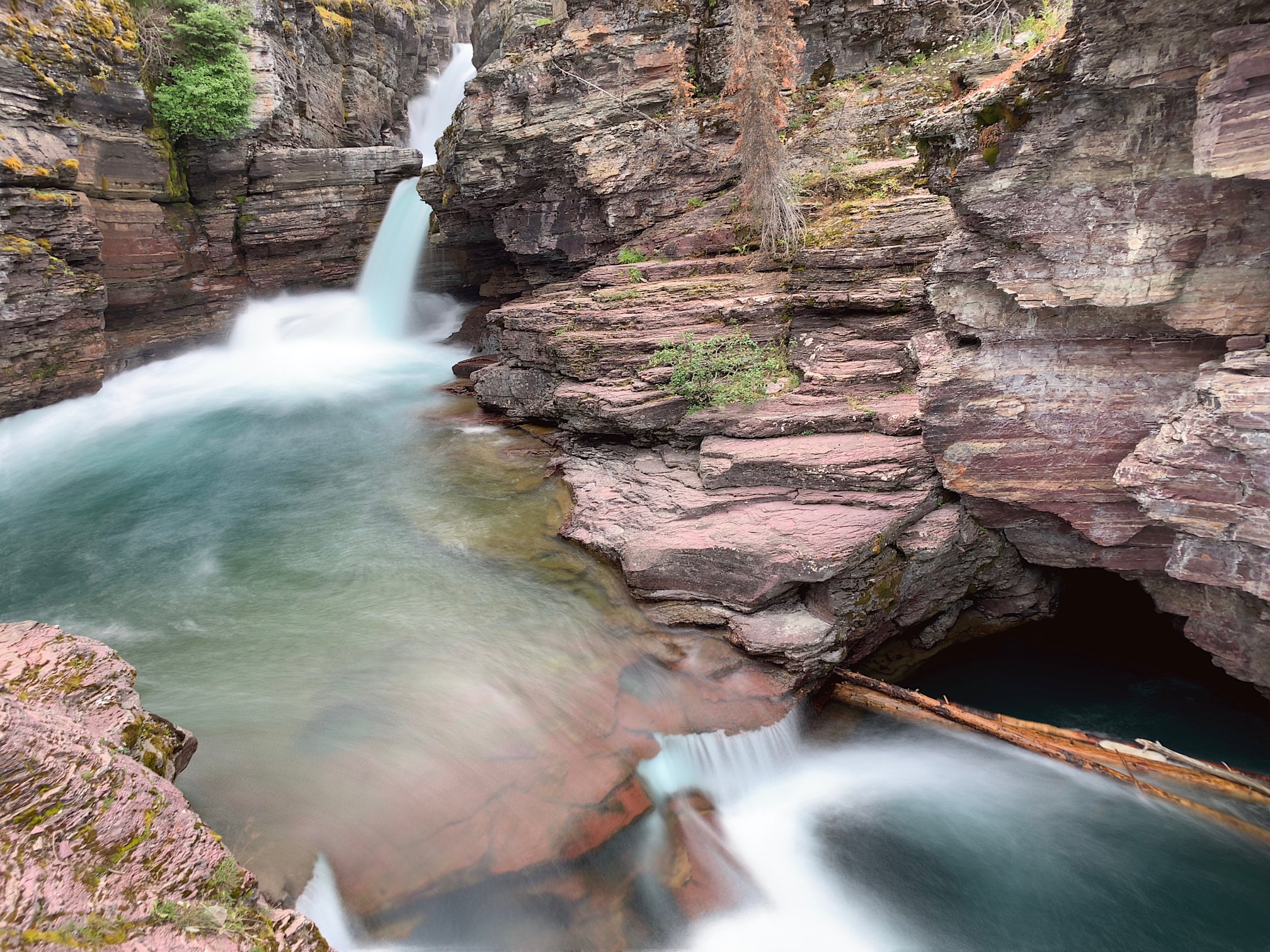 Saint Mary Falls only drops 35 feet, but it does so in three brilliant blue tiers through a tight rocky cut in the Saint Mary River, which flows down into Saint Mary Lake. We would see more falls on our vacation, but this one was a beauty. Looking back, we should have possibly continued on to Virginia Falls, only another mile or so up the trails. The skies were clouding over again, however, and the day was growing long. And we had a few hours in the car that evening before our next bed for the night. We headed back to the Forester and got back on the road, gassing up in Saint Mary before turning north.
Saint Mary Falls only drops 35 feet, but it does so in three brilliant blue tiers through a tight rocky cut in the Saint Mary River, which flows down into Saint Mary Lake. We would see more falls on our vacation, but this one was a beauty. Looking back, we should have possibly continued on to Virginia Falls, only another mile or so up the trails. The skies were clouding over again, however, and the day was growing long. And we had a few hours in the car that evening before our next bed for the night. We headed back to the Forester and got back on the road, gassing up in Saint Mary before turning north.
Glacier National Park remains a treasure of the U.S. National Park system. With anthropogenic fossil fuel use driving permanent (for human purposes) climate systems change to the local environment, the landscape has already seen massive alterations. Glaciers once dominated the park they were named after. Now, ice and snow pack remnants are all that remain, along with moraines and other structures that make it clear how much ice has been lost. The park’s vibrant summer fields of flowers and abundant wildlife still remain, at least for now. With an extensive hiking system, and one of the most renowned automotive routes in the nation (Going-to-The-Sun Road), Glacier also brings in nearly three million visitors a year. Like many of the other “crown jewel” parks in the national system, Glacier is at times overrun by the one species that does the most harm to any natural environment – humans. While many of us are responsible with our litter, with staying on the established trails, and with the inevitable interactions with wildlife (we only came “close” to one critter, a deer who wanted to share the trail on the way back from Saint Mary Falls), many more do not. We spotted the occasional piece of human refuse, and the irony of driving an internal combustion engine powered vehicle right into the heart of what was once glacier country was not lost on me. We are like termites infesting a home, chewing up all the available resources, but also spewing hazardous waste into the very air we breathe and the water we drink. For the wildlife struggling to adapt to our presence (some have done very well at this, especially in a park environment), simultaneously being forced to adapt to warmer temperatures, and the shifting patterns of food and water that will result from that, may be too much.
I am personally divided on how best to preserve the wild country we still have left. Wall it off? Prevent tourists and adventure types from entering, only allowing professional scientists and researcher’s access? That might be best for the land, and the species of plant and animal that call it home. But would it help humanity in understanding and respecting these areas if we restricted access, never to allow the regular citizen to see what we are trying to protect? I don’t think it would. If we are to change our ways, how we view our own position in the biosphere, we must actually get to know these magnificent and precious parcels of wild land. We must see, touch, smell, and feel areas like Glacier National Park. Of course we need to do so with care and caution, not to upset any further the delicate balance we have pushed so drastically off center. Walk-in, walk-out hikers, and group tour groups may be the future, as the one impact we need to ween ourselves of the most, the personal automobile, could perhaps be limited in future years. Park you vehicle at West Glacier or Saint Mary, and join a larger group for a full day in the park. Ten to twenty vehicles become one.
I don’t know what the solution will be. How we eventually and for perpetuity save our National Parks. But I do know they are worth protecting, even from ourselves. We owe it to our future generations, and more importantly, to Earth itself, to preserve as much wild spaces as possible.
I would love to return to Glacier again in a few years, to spend more than a day and a half in the park. I would love it even more for there to be some ice and snow left to see when we return, but I know the chances of that are growing dim.
We headed north, putting Glacier National Park in the rear view mirror, and within an hour of leaving Saint Mary, crossed into Alberta, Canada, where we would spend the next four nights.
**********
The next entry will discuss the remainder of our 2019 family vacation, during which we visited the most stunning mountain landscapes I have seen yet in North America – Banff, Yoho, and Jasper National Parks in Canada.
